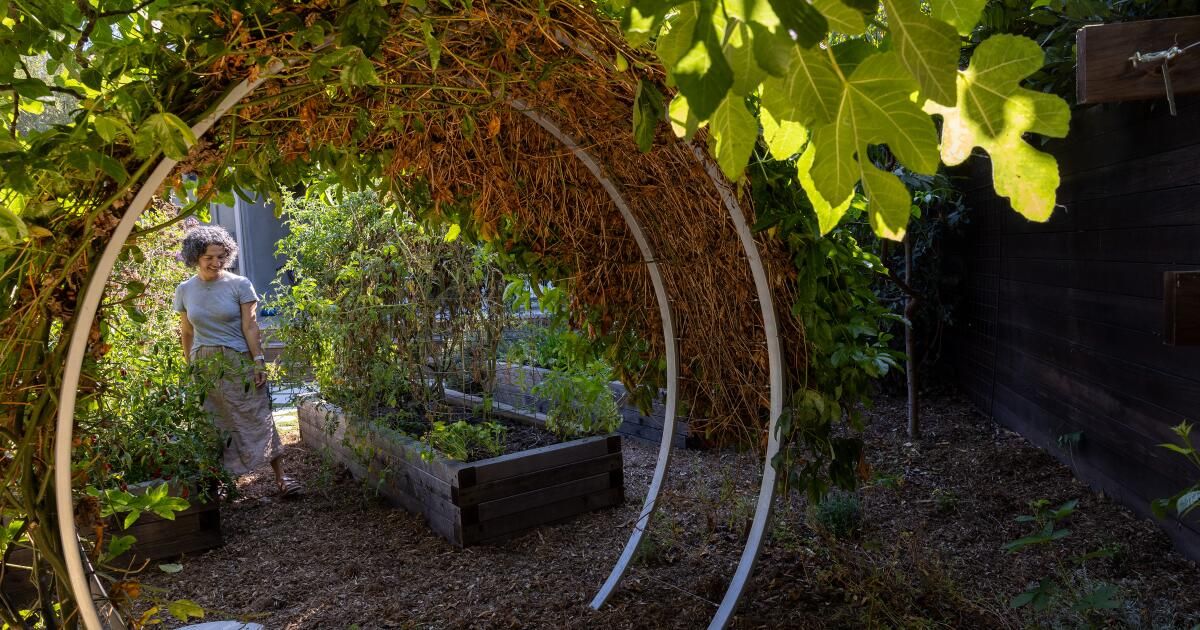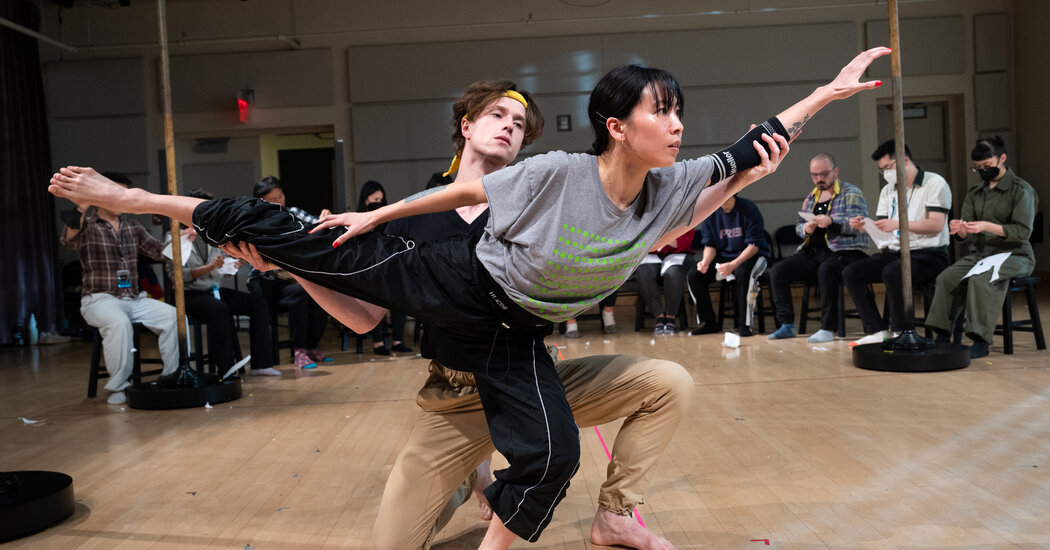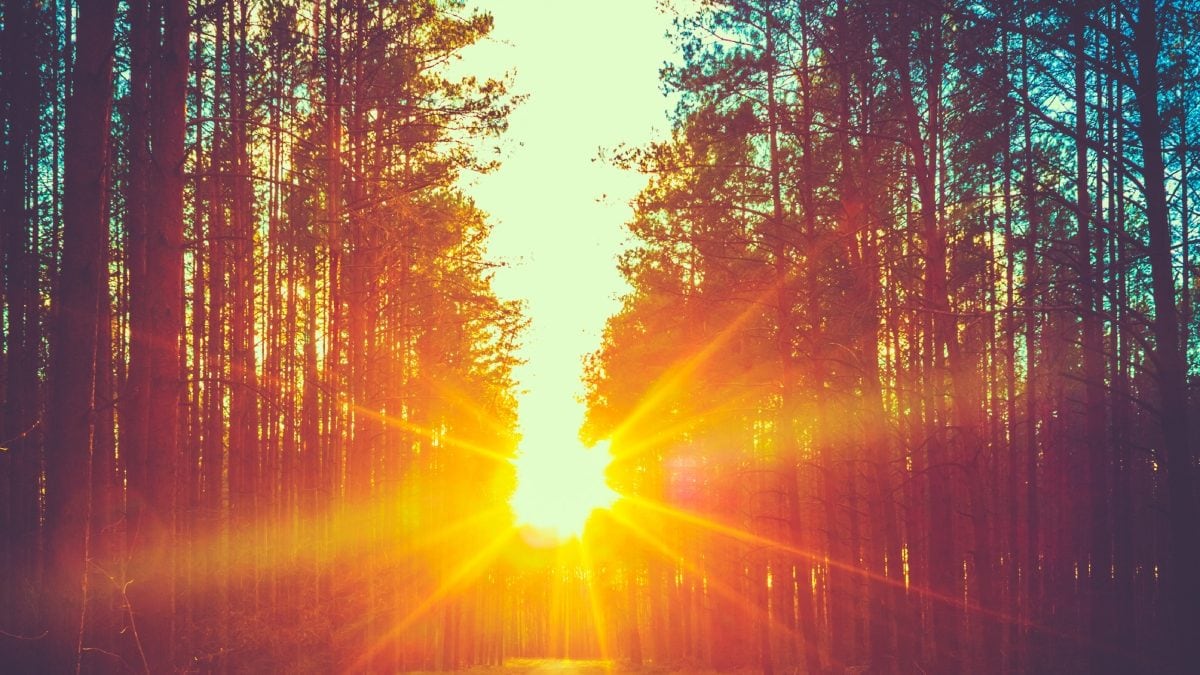Water-hungry lawns are symbols of Los Angeles' past. In this seriesWe highlight patios with alternative low-water landscaping built for the future.
Like most families stuck at home during the pandemic, psychologist Angel Black and her husband, philosophy professor Tim Black, struggled to maintain their careers while helping their children manage their learning.
Angel Black picks peppers in her backyard garden.
Fortunately, Angel had a dream/distraction up her sleeve: to transform the family's grass-filled Culver City yard into a “large food-producing area,” where the Blacks' two children could wander and graze while she farmed. the products you longed for.
It all came together in an unexpected way to create a mini-farm backyard retreat that also provided hands-on landscaping lessons for her curious 8-year-old son, Early, whose alternative school closed in the early weeks of the pandemic shutdown. Her daughter, Ruby, then 13, could go to school online, but that wasn't an option for Early's outdoor school.
“I had tried growing things on my own in a small raised bed, but nothing worked,” Angel said. “I just didn't know how to get enough sun. So I Googled “transform a backyard into a food growing space.” The Farmscape website came up and I thought, 'Oh my God. this That's who I need.'”
Angel met Farmscape designer Catherine McLaughlin in January 2020, a few months before COVID-19 shut down the world. She immediately understood what needed to be done, McLaughlin said.
The tiny raised beds in the Blacks' backyard produced mediocre crops, if anything, because they were hidden under large fig and avocado trees, McLaughlin said. The grass in the backyard absorbed most of the sun, and the grass in the front yard, heavily shaded by the stately elms that lined the block, was so compacted and sun-deprived that it was “basically already dead.”
Often the biggest problem with grass removal projects is getting everyone to agree to remove it, McLaughlin said. “It is very difficult for the family (usually husbands) to give up their grass space. It is ingrained in us: we have a great attachment to flat green monocultures. “People like to see the extent of their land and they justify it with this vague idea like, 'Someday we'll play soccer there.'”
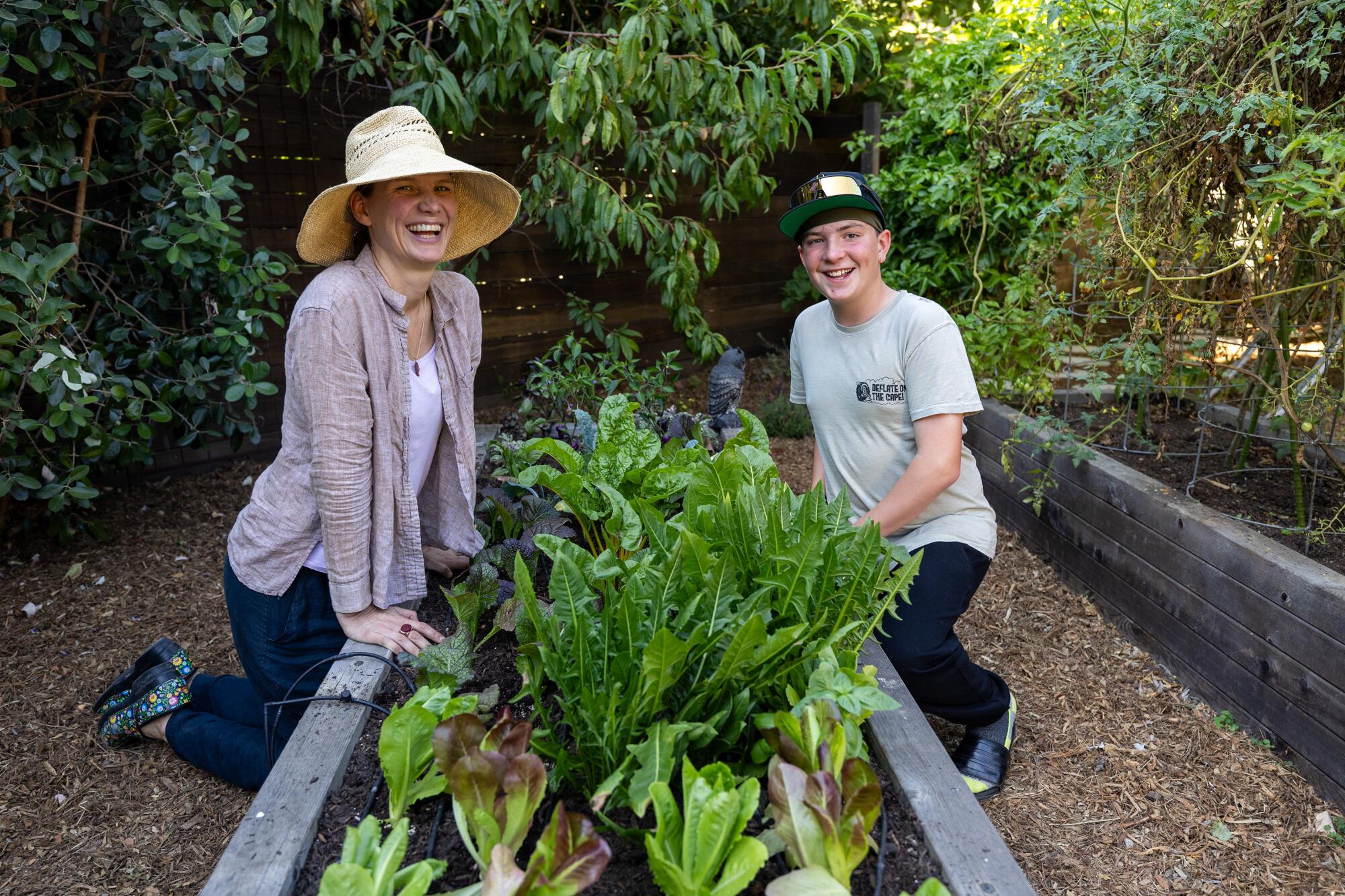
Landscape architect Catherine McLaughlin, left, and Early Black, right, kneel next to one of the raised beds Early helped her team build four years ago, when she was 8 years old.
Your technique for easing the transition? Encourage reluctant lawnmowers to use nearby parks, which in the Black family's case are just a block away.
Fortunately, Early, the biggest grass user, was excited about the idea of renovating the yard, Angel said. Her husband and daughter loved the idea of growing food as long as “they didn't have to do gardening,” she said, laughing. And she was eager to learn everything she could about how to plant and maintain a garden.
But ultimately, it was the pandemic that provided the catalyst to remodel their entire 5,000-square-foot garden. They spent about $50,000 to transform their front and backyard, but it also transformed their lives, Angel said, providing the family with garden retreats, lots of fresh vegetables and hands-on lessons for Early.
The lessons were an added surprise, Angel said. When Farmscape brought out all of its equipment to begin removing the grass, Early was enthralled.
“He said, 'Wait a minute, look at these cool machines they're using to dig up my yard,'” Angel said. “He didn't have school at the time, and he and the foreman, Lowell Frank, really hit it off. Early would sit outside and watch them, and one day Lowell invited him to join them. After that, Early was there at 8 a.m. every day for six weeks and could do everything, including pushing the tiller. He attended landscaping school for six weeks and it was amazing.”

Landscape designer Catherine McLaughlin, left, chats with Angel Black in the Black family's backyard, under the ample shade of large fig and avocado trees that have been pruned to provide more sun for growing vegetables.
“[Frank] He was very patient when teaching him,” said Ángel. “To keep costs down, they said maybe we could help with some of the planting, so Early and I got really involved in the garden.” Frank has since moved to New Mexico, Angel said, but before he left, he made Early his own toolbox and filled it with garden tools. The two have kept in touch by exchanging letters.
The front yard was also designed with Early in mind, McLaughlin said. They built a berm to provide privacy to the small seating area by the front door and added primarily native plants such as California fescue, sage, sagebrush, yarrow, blackcurrant, coastal daisy and spring wildflowers, as well as edibles such as lettuce. mining. and ruffled chrysanthemum (a non-native edible green).
Farmscape was so busy in 2020 that work didn't begin until that fall. The backyard lawn was removed to make way for three deep raised beds made of stacked 4-by-4-inch redwood posts. The fig and avocado trees were pruned a little to give the garden as much sun as possible; a round steel trellis was installed on a walkway to support a thriving passion fruit vine; A guava hedge was cut down to make room for a blackberry orchard and fruit trees such as white nectarine and pomegranate; and thick mulch was placed around the walkways to deter weeds.

The Blacks' backyard mini-farm includes three large raised beds constructed of 4-by-4-inch redwood posts stacked five high to create deep, sturdy and attractive planting areas.
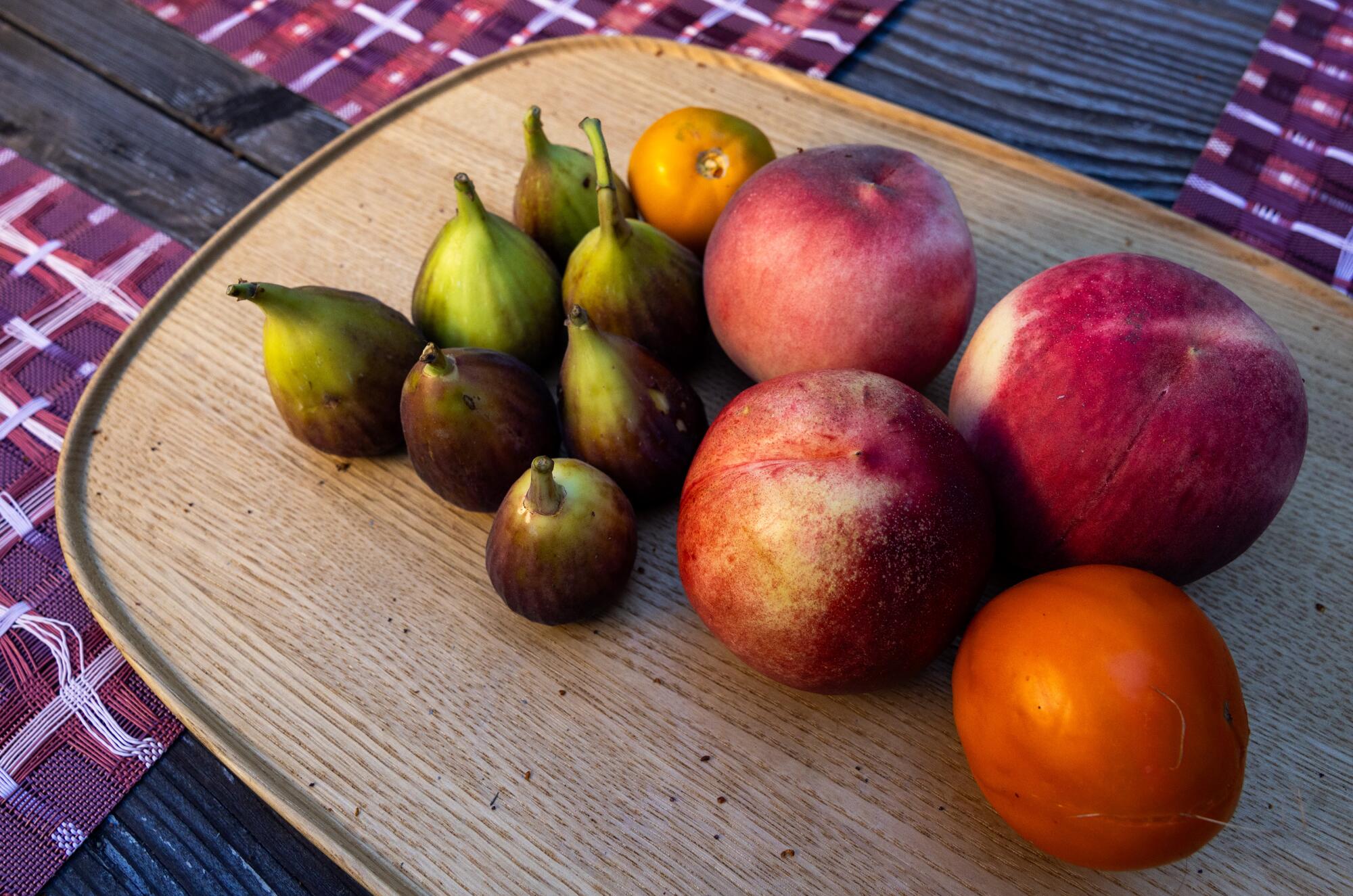
A sample of Angel Black's daily garden harvest includes figs, nectarines and tomatoes. Not shown in the photo are the many peppers he also picked that day.
Now the backyard feels like a series of outdoor spaces, with the terrace leading to the raised garden that leads to the quiet seating area shaded by ripe and very productive figs and avocados. Further back is the three-tier composting system created by Farmscape, which Angel says is the “secret sauce” to his garden’s success.
“That first summer, when we put compost in our garden, it was crazy,” he said. “I was like, 'Ohhh, so this “That’s how you get 9-foot-tall tomatoes.”
Finding enough sun to grow healthy crops was another matter. The garden beds are positioned at an angle to the terrace, according to readings McLaughlin obtained from her Sun Seeker Tracker Surveyor app ($9.99), which allows people to track the sun's movement through their garden at different times. times of the year.
“We recommend this app to anyone trying to better locate their orchard,” McLaughlin wrote in a text. “We think $9.99 is a good insurance policy against years of stunted vegetables” because they don't get enough sun. Warm-season vegetables, such as tomatoes, peppers, and cucumbers, need at least six to eight hours of sunlight a day to thrive.
Farmscape usually maintains the raised gardens it creates, visiting sites weekly to keep everything tidy, but Angel was so involved in doing the gardening herself that McLaughlin says her team only comes in a couple of times a year now to do seasonal maintenance, how to help her “Flip” beds from a summer garden with tomatoes, peppers, chard, basil and cucumbers to a winter garden full of greens, broccoli and sweet peas.
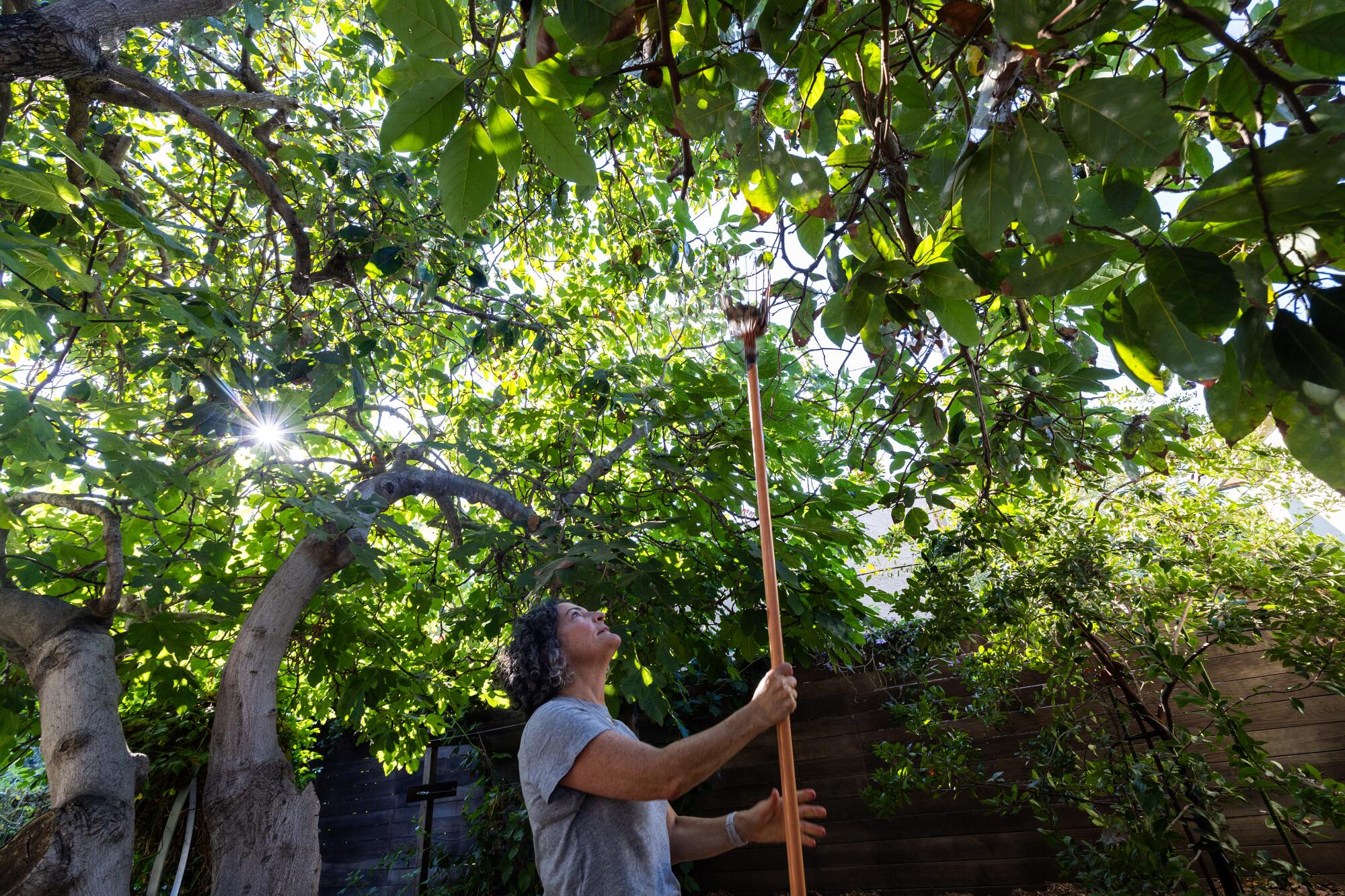
Angel Black picks avocados from a tree in her backyard garden.
“We are not vegetarians, but I am a big vegetable consumer and I would say that every day something of our meals comes from the garden. We are people who eat salads every day, so I always plant tons of lettuce in the winter, as well as mustards, collards and kale,” Angel said.
“This garden has turned out much better than I ever imagined and we get much more food than I ever imagined; I love giving food to family and friends, but I also freeze a lot. In the case of tomatoes, did you know that you can freeze them whole and then when you are ready to use them in a soup or stew, you can simply soak them in water and the skin will fall off?
(Her technique, for other people who have too many tomatoes, is to put the whole tomatoes on a cookie sheet until they are completely frozen and then put them in freezer bags to store, until you need them for winter meals.)
Angel said she was “shocked” by the drop in their water bill, to about a third of what they paid when they watered their lawn. “I didn't know how it was going to be possible because we had a lot more plants to water, but switching to drip irrigation made a big difference from regular sprinklers.”
And early? Now that he is 12 years old, his interest in gardening has given way to another passion: baseball. He is a pitcher and catcher and there is a small batting cage in the backyard where he can practice, between the garden beds and the terrace.
Four years later, his feelings toward the garden and lawn have changed a bit. “It would be great to have some “There's grass here,” he said slowly, as his mother and McLaughlin held their breath, “but it's so much better this way.”
Because? He looked around the garden, reflecting. “Since we have a lot of food now, it looks better…” he trailed off and flashed a mischievous smile at the two women, “and I don't have to cut it.”

